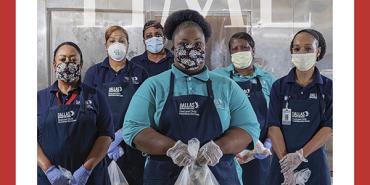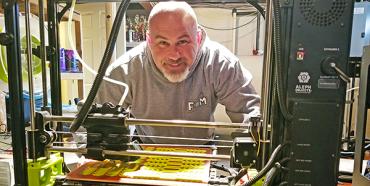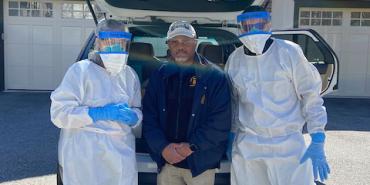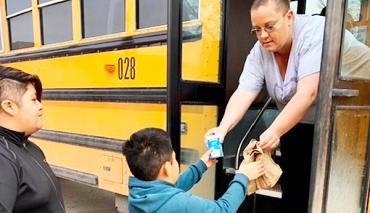Fred Rogers, that great public educator and cultural icon, said when “scary things” happen—during crises like the coronavirus pandemic—“look for the helpers.” At the AFT, we are the helpers.
From the nurses caring for COVID-19 patients to bus drivers delivering meals for children, AFT members are everywhere, helping to mitigate the impact of this unprecedented pandemic.
In the hospitals
Being a nurse has never been an easy job, but now it is fraught with unimaginable complications. Some nurses are moving out of their homes to protect their families from exposure to the virus. They are witnessing death, over and over again, most often while patients are alone, with little time to comfort families before the next critically ill patient arrives. They are overworked and underprotected, experiencing shortages in personal protective equipment like N95 face masks and face shields. Some are wearing plastic bags as protective gowns and reusing masks designed for single use only.
“We’re starting to see more and more cases in our hospitals, and folks are sicker and sicker,” said Rick Lucas, a rapid-response nurse and president of the Ohio State Nurses Organization, on MSNBC. Over the Easter weekend, things were especially rough. “We saw a lot of our peers fall ill with COVID, quarantined away from their families … and lots of patients requiring ventilator support and critical care.” Outside the hospital, some nurses are facing eviction because their landlords see them as a health threat, said Lucas.
The AFT is supporting these nurses, health workers and hospitalists by amplifying their request for more PPE, lobbying for legislation that will provide them with equipment they need and supporting them as workers in every way possible. Advocates can sign a petition to urge the federal government to prioritize the production of PPE and to release existing equipment.
“I want to take care of my patients to the best of my ability; everyone I know does,” said Deb Snell, an intensive care unit nurse and president of AFT Vermont and the Vermont Federation of Nurses and Health Professionals, on CNN. “I want to take care of you, but I can’t take care of you if I’m in the bed next to you.”
Union support
Affiliates are providing practical support: In Brooklyn, for example, the Federation of Nurses/ United Federation of Teachers is distributing meals to nurses and providing free counseling every day. “This is an incredibly, incredibly sad situation for all of us,” said Howard Sandau, an ICU nurse and member of the Federation of Nurses/UFT, on MSNBC. “We’re fighting day and night trying to save people’s lives, and unfortunately we’re not able to save everybody. This does take an emotional toll.”
New York State United Teachers has its own disaster relief fund to purchase PPE, food and other items for healthcare workers as well as a PPE donation program. The Professional Staff Congress, which represents faculty and staff at the City University of New York, has teamed up with the New York State Nurses Association to create the Homework Hotline for the children of nurses, staffed by union volunteers.
The AFT has a deep well of resources for healthcare workers and all our members at AFT.org/coronavirus.
Filling the gaps
Surviving crises calls for flexibility and resourcefulness, something AFT members have in abundance. Seeing the need for PPE, Michael Shunney (pictured above), an industrial technology teacher in Rhode Island, has involved his high school students in using the school’s 3D printers to churn out hundreds of face shields from their homes. Shunney’s union, the West Warwick Teachers’ Alliance, is buying materials, and school administrators are purchasing more printers to expand the effort. “This is our version of the Great Depression,” says Shunney. “The people on this project will … look back and say, ‘We had COVID-19, and this is what we did to help.’ It gives you a little bit of hope.”
State University of New York physicist Allen Anderson has supplied face shields for campus police and emergency medical services on his Oneonta campus, and sent more out to community healthcare workers. And two high school teachers from Nashua, N.H., have been making face masks and sending them to New York City since early April.
School nurses from the Visiting Nurse Association of Southeastern Connecticut/AFT Connecticut union are using their time out of school to serve at coronavirus testing sites, through an assignment secured through their union. Others are going door to door in their communities. “I’m 65, and I am not healthy, but I made a commitment to the work, and I had to do the right thing,” said one member, who describes her experience on AFT Voices.
Also out testing: volunteers like Wayne Spence (pictured below), a parole officer who is also president of the Public Employees Federation in New York. He is driving public health employees out to test for COVID-19 in the community. Other PEF members, employees at the New York Department of Health’s Wadsworth Center in Albany, helped develop one of the coronavirus tests that is in heavy usage today.
Feeding the community
Not every need is directly tied to medical care: Pandemic closures have shut many families out of the schools that provide their primary source of food and stability. Enter affiliates like NYSUT, which organized a food bank and accepted 15,448 pounds of food donations in fewer than five days. “I’m so proud of our members,” Brentwood Teachers Association President Kevin Coyne told NYSUT publications. “You look at the list of donors, and there’s an incredible number of individual members, plus so many local union associations.”
In Los Angeles, the grab-and-go food program, which serves millions of meals to families at thousands of school distribution sites, is fueled by dedicated food service members of the California Federation of Teachers.
In Dallas, those workers were recognized for their service on the cover of Time magazine: “I’m a server for life,” food service veteran Yolanda Fisher told Time. “It’s an honor to serve those kids who really need it.”
Ohio educators who normally work in classrooms are pitching in at distribution sites in Cincinnati, helping up to 70 families at each site, each day. They are joined by community members who are donating hygiene products, toys, snacks and Wi-Fi access—this is a broad effort that cuts across the business community as well as local government and unions.
In more rural areas, like Grants, N.M., school bus drivers are delivering meals right to the neighborhoods where their students live. “Working at the meal sites and driving our routes to deliver food is strictly optional,” said Tia Harris, a school bus driver and president of the Cibola County Federation of United School Employees. “It’s just one of the many ways we are making the community our responsibility during this difficult time.”
The work does not go unnoticed: Teachers, school staff and some parents lined up in a 15-car parade complete with homemade signs, driving past their school in Springfield, Ore., to thank the food service workers who provide 300 meals a day for neighborhood children.
We must keep teaching
After scrambling to set up remote learning opportunities and struggling to be sure every student could participate, teachers and paraprofessionals are now immersed in the challenge of delivering home learning. Some are relatively simple, like Farrah Alexander’s setup in a corner of her bedroom: There, the New York City pre-K teacher uses puppets and reads aloud to give her students some semblance of familiarity and emotional support. “It’s super important for them to see us, to feel like we’re talking to them, that we’re connecting to them,” she says.
In Chicago, some educators connected by driving through their students’ neighborhoods, where families held up messages and greetings for their teachers on porches and in yards. On a more serious note, the Chicago Teachers Union is a driving force behind reaching every child, as it monitors the racial and socioeconomic disparities COVID-19 is raising and advocates for a more equitable response.
Meanwhile, teachers are using social media to share the different ways they are reaching out to students—how they are packaging worksheets and supplies for students who can’t get online, how they’re modifying lessons. The AFT’s Share My Lesson has a rich collection of ideas from educators, for educators, about remote learning and more information for educators themselves on how to cope during this challenging time.
For more tangible resources, several AFT affiliates have partnered with First Book to distribute free books for children during their time away from school. Ten thousand books went to 2,100 children living in Win shelters, the largest provider of family shelter and supportive housing in New York City. Six pallets of books are going out to families in Cleveland; and the Rhode Island state federation has nearly 8,000 books going to students in Providence and Central Falls. Ohio’s Brookfield Federation of Teachers has lined up 1,500 books for a “book drive through,” and the Cincinnati Federation of Teachers has been distributing through the Language Enrichment and Academic Proficiency program, a Spanish-language magnet school.
“We must keep moving, we must keep teaching,” says Fashion Institute of Technology professor Lisa Donofrio. To keep her students on track for college graduation, she and her colleagues in the United College Employees of FIT have adapted would-be lab work, such as machine knitting, to handwork, and some have set up makeshift tailoring studios in their homes.
“We have gone back to the World War II motto,” says Donofrio. “Make do and mend.”
[Virginia Myers]




